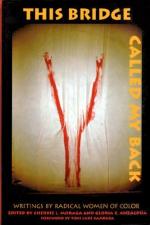
|
| Name: _________________________ | Period: ___________________ |
This test consists of 15 multiple choice questions and 5 short answer questions.
Multiple Choice Questions
1. According to Doris Davenport, what is wrong with the word "racism"?
(a) Too general and simplistic.
(b) Too accepted.
(c) Too specific.
(d) Too much incorrect history.
2. From where did the quote at the beginning of "on not bein" come from?
(a) "Poetic Voices."
(b) "Nappy Edges."
(c) "Martinique's Song."
(d) "Dark Voices."
3. Of what race is Gloria?
(a) African American.
(b) Spanish.
(c) Chicana.
(d) Indian.
4. "For it is only under a patriarchal structure that _____________ is the only social power open to women," according to Audra Lorde.
(a) Gossip.
(b) Education.
(c) Feminism.
(d) Maternity.
5. Who wrote "I Am What I Am"?
(a) Patricia Smith.
(b) Lynne Hanley.
(c) Toni Morrison.
(d) Rosario Morales.
6. What does the narrator croon in "I Am What I Am"?
(a) Carlos Gardel tangoes.
(b) Rafael Ithier poetry.
(c) Jorge Arraiza songs.
(d) Skitzo rap.
7. Why was the author of "La Guera" pulled out of school at the ages of five, seven, nine, and eleven?
(a) To take care of her ailing mother.
(b) To work in the fields.
(c) To work in a silk factory.
(d) To work in a factory.
8. Who staffs the Buen Muir Indian Trading Post?
(a) Spanish.
(b) Mexicans.
(c) Whites.
(d) Indians.
9. What did the subject in the poem, "on not bein," not ever want to be?
(a) Black.
(b) White.
(c) Spanish.
(d) Female.
10. Who confided in Cherrie Moraga that he felt she didn't trust him because he was a male?
(a) Her brother.
(b) A gay friend.
(c) Her father.
(d) Her college mentor.
11. According to a reference to another author in "La Guera," where must one look to find the dream?
(a) The nightmare.
(b) The ego.
(c) The inner self.
(d) To the past.
12. According to Cherrie Moraga, what does lesbianism equal in "this country"?
(a) Poverty.
(b) Hatred.
(c) Second-class citizenship.
(d) Misunderstanding.
13. Who is quoted at the beginning of "La Guera"?
(a) May Swenson.
(b) Judith Wright.
(c) Susan Howe.
(d) Emma Goldman.
14. What taught Cherrie Moraga that "we are not human beings"?
(a) Her Chicana heritage.
(b) Her oppression for being female.
(c) Her lesbianism.
(d) Her failure in school.
15. Why does Rosario Morales carry a "pole 18 inches long"?
(a) To protect herself from America.
(b) To protect herself from 13-89 year old men.
(c) To maintain her right to be proud of her culture.
(d) To protect herself from right-winged feminists.
Short Answer Questions
1. What "problem" is addressed in the first section of the book?
2. Who provided the scholarship for Gloria to attend the workshop on goddesses and heroines?
3. What does the narrator in "Wonder Woman" wonder about the professor's wife?
4. What does the author want to make changes in, according to "Invisibility is an Unnatural Disaster: Reflections of an Asian American Woman"?
5. How does Doris Davenport write "women"?
|
This section contains 454 words (approx. 2 pages at 300 words per page) |

|




